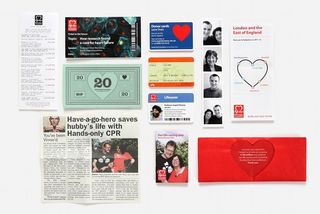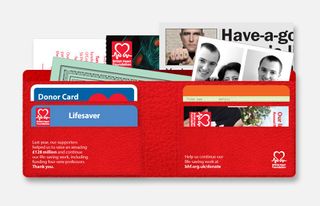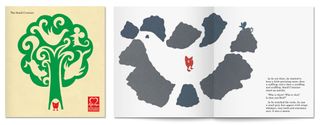Louise Kyme on the challenges facing charitable design
The British Heart Foundation's brand and design manager discusses the charitable design sector in the run-up to her talk at Impact conference.
As the credit crunch continues to tighten people's purse strings, charities are having to be ever more creative in order to encourage people to part with their pennies - a challenge Louise Kyme knows only too well. As the brand and design manager of the British Heart Foundation, Kyme is responsible for combining design savvy with understanding of the charity scene to boost the charity's success.
She'll be joining Michael Johnson and ThinkPublic founder Deborah Szebeko on stage at Computer Arts' Impact conference on 6 March to discuss how the charitable design sector is dealing with the new challenges being placed before them.
It must have be more and more difficult to encourage people to donate during a recession. How has BHF responded?
The UK has been through some challenging economic times in recent years. However, we have worked hard to diversify and ensure supporters can give in lots of different ways, whether that is through signing up to an event, making a regular gift or leaving us a legacy. This has been successful and last year saw an increase in voluntary income for the BHF.
Since moving to BHF, what's the project you've been most proud of in terms of pushing the boundaries of creativity?
We always place big emphasis on our Annual Review and use it as an opportunity to create emotional connections with our audiences. To do this, we throw the 'Annual Review rule book' out the window, and challenge our designers to surprise people and make them take action.

NB:Studio took that challenge to a new level in 2012 when they created the BHF life-saving wallet, which used typical items you'd find in a wallet to tell our story.
For example, they designed a train ticket to show the success of the London to Brighton Bike Ride, a bank note to show how we could use people's donations, and a till receipt itemising everything we'd bought over the past year (from research to defibrillators to nurses). This clever idea made our work more accessible to both young and older generations.
In the charity sector, the results can be tricky to quantify. How do you benchmark the success of a project?
We are a people-focused charity, and throughout a project's progress we will use various means of research or evaluation to make sure the final outcome is going to have the positive impact it needs.
That might be using focus groups at the early stages of a project, seeking input from our teenage Facebook group, or running a full user evaluation a year later. The learnings we gain about how people engage, interact and respond are vital to our progress.

Focus groups can sometimes be seen negatively by the design industry, but when your business is changing people's behaviour (whether by eating a healthy diet, quitting smoking or taking up exercise) relying solely on a designer's instincts isn't enough.
Ultimately, judging the final success of a project is very challenging. For example, for a booklet with heart-healthy recipes; we can count how many copies we distribute. We can ask people if they found the format and design easy and inspiring to use. We can ask them if the used the recipes. But that's about as far as it goes. We can't be with them every day of the week to monitor if they eat healthily for a sustained period of time, which would be the ultimate success.
BHF has worked with top studios including Hat-Trick, NB:Studio and Magpie. What are the benefits of collaborating with traditional studios?
Agencies like these are generally driven by ideas, craft, and ownership of the project. They are totally focused on you, your project, and its ultimate human impact. They are still commercially driven, but I wouldn't say that's the main driver for their involvement on a project, and this makes a considerable difference in their dealings with you.
That approach works great alongside the kind of people who work within a charity. So as a result, you get a perfect storm: a team from both agency and client who are committed, open minded, and often selfless in their workings to get the best end product. This makes a great springboard for high-calibre creativity.

'Small Creature', our resource for bereaved children, is a good example of how the creativity of an empathetic design studio (Hat-trick) and client, can produce something that is emotionally sensitive whilst using design as a tool to create positive change.
Exclusive offer: 20 per cent off tickets for new brand conference

Impact is an event you can't afford to miss – and we're offering Creative Bloq readers a massive 20 per cent off the ticket price. Simply:
- Visit the website
- Enter your registration details
- Add this Promotional Code when prompted: FRIENDS20
Want to know more about Impact? Click here and we'll give you all the details.

Thank you for reading 5 articles this month* Join now for unlimited access
Enjoy your first month for just £1 / $1 / €1
*Read 5 free articles per month without a subscription

Join now for unlimited access
Try first month for just £1 / $1 / €1
Get the Creative Bloq Newsletter
Daily design news, reviews, how-tos and more, as picked by the editors.
The Creative Bloq team is made up of a group of design fans, and has changed and evolved since Creative Bloq began back in 2012. The current website team consists of eight full-time members of staff: Editor Georgia Coggan, Deputy Editor Rosie Hilder, Ecommerce Editor Beren Neale, Senior News Editor Daniel Piper, Editor, Digital Art and 3D Ian Dean, Tech Reviews Editor Erlingur Einarsson and Ecommerce Writer Beth Nicholls and Staff Writer Natalie Fear, as well as a roster of freelancers from around the world. The 3D World and ImagineFX magazine teams also pitch in, ensuring that content from 3D World and ImagineFX is represented on Creative Bloq.
